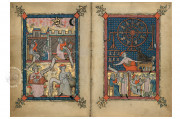The Rothschild Canticles is a stunning and richly illuminated collection of Christian meditations created for a nun or cannoness. Made around 1300 at the Benedictine monastery of Saint-Winnoc at Bergues in northern France, the manuscript presents a sophisticated program that combines extracts from the Bible, the liturgy, and early Christian and medieval authors in unique combinations to prompt contemplation of Christian mysteries. Its program of illumination features more than 200 miniatures, twenty-three tinted drawings, forty-one historiated initials, and dozens of amusing creatures in marginal vignettes.
The text is in two parts of nearly equal length. The first guides the reader/viewer through the spiritual contemplation of Paradise, the Song of Songs, the Virgin Mary, and the Trinity (fols. 12v-106r). The second part is an ensemble of texts and images addressing the vices, virtues, and monstrous races, exempla (moralizing stories), theology, and biblical books of wisdom (fols. 107v-188r).
Pictorial Invention
The miniatures are the work of two illuminators from St.-Omer. They commanded all aspects of the northern French Gothic painting style. The scenes in the miniatures and historiated initials are set against burnished gold or diapered (geometrically pattered) backgrounds. The figures appear to be solid, their drapery falling in broad folds, and hand gestures are exaggerated.
Many subjects depicted are unique to the manuscript, and the painters take innovative approaches to familiar subjects. The Tree of Jesse, for example, was well established as a visualization of Christ's lineage. In the Rothschild Canticles, the subject is transformed by the omission of Christ and the presence of groups of Jews and branches of thorns at the head and foot of Jesse (fol. 46r).
Seeing the Holy
The usual arrangement in the manuscript's first part is in diptychs. Text and a small miniature occupy the left-hand page, and a full-page miniature fills the right-hand page. The small miniature depicts a "seer," a prophet-like figure that draws the reader/viewer's attention to the miniature on the facing page. The seers often point, but they might gesticulate—expressing awe—or turn to gaze at the large image.
Focus on the Trinity
The culmination of the first part is a series of almost twenty openings focused on the mystery of the Trinity, the Christian deity that is three persons and yet one. The representations are the most original of the book, and each artistic rendering only hints at the mystery.
Perhaps the most astonishing image is the miniature illustrating "My center is in all places, my circumference nowhere." Each person of the triune God—Father, Son, and Holy Spirit—is partially visible from behind a wheel representing the one God. The Father and Son grasp the wheel, and their feet touch behind it (fol. 104r).
Picturing Vice and Monstrosity
The manuscript's second part is more conventional in presentation. It is profusely illuminated, and myriad painted hybrid and fantastic creatures occupy its margins. This portion opens with considerations of the vices and virtues, followed by texts on the people understood as "monstrous," with miniatures depicting the seven vices and the physical features of the monsters (fols. 107v-119r).
Desert Fathers in Tinted Drawings
A series of delicately drawn full-page tinted drawings was added to the manuscript shortly after the contemplative content was completed. Interspersed mostly in pairs through three-quarters of the book, they depict narrative scenes from the lives of the Desert Fathers (early Christian hermit-monks of Egypt).
Unique Bouquet of Texts
The Canticles manuscript is a florilegium, a collection of "flowers" (excerpts) from diverse textual sources. Among the most quoted are De trinitate by Saint Augustine and the Elucidarius of Honorius Augustodunensis. Two scribes copied the spiritual texts in Gothic Textualis script. A third scribe wrote a text in Middle Dutch with influences from Middle High German (fol. 190r).
From One Volume into Two
The book was given in 1856 by William Alexander Archibald Hamilton (1811-1863), Duke of Hamilton and Brandon, to Walter Sneyd (1809-1888). It owes the Rothschild of its nickname to Edmond (1845-1934), Baron de Rothschild, a twentieth-century owner. Bound in two volumes since 1966, the manuscript was acquired by the Beinecke Library in 1968.
We have 1 facsimile edition of the manuscript "Rothschild Canticles": Rothschild Canticles facsimile edition, published by Quaternio Verlag Luzern, 2025
Request Info / Price


























